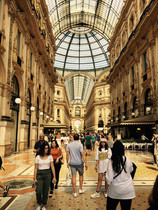Taken from the second issue of our magazine, we look at the history of art, tradition and culture in Milan and how this transcends onto the pitch at the iconic San Siro.

There aren’t many cities as well recognised as Milan. The very mention of the city around the World instantly brings to mind images of fashion, design, industry, art and of course football. As a thriving global city, Milan is iconic in so many ways. One of the four fashion capitals along with London, New York and Paris; Milan's immaculately dressed residents and high end designers have solidified its reputation as one of the most stylish cities on the planet.
As Italy’s financial and industrial capital, Milan is also rich in art and culture, home to Leonardo da Vinci's The Last Supper, as well as one of opera's most iconic venues, La Scala. At the heart of the city lies the breathtaking Il Duomo, and from just glancing at its wonderfully intricate marble facade, you can appreciate how it took almost six centuries to be completed. Next to the Cathedral in Piazza Del Duomo lies another of Milan's beautiful landmarks, Galleria Vittorio Emanuele II.
As a common Milanese meeting and dining place, the Galleria links Il Duomo to La Scala and is Italy's oldest shopping mall. Under its arching glass and cast iron roof are numerous luxury restaurants, cafes and retailers such as Prada, Versace and Armani, whilst the mosaics and amazing colours that reflect from its walls make a casual stroll through quite an incredible experience.
There is another iconic landmark in the city that is also familiar to so many around the World. It's sweeping exterior and marvellous roof surround a pitch that has hosted some of the most dramatic, extraordinary and sublime goals, matches, teams and players in football history.
The San Siro is a stadium that has come to mean something to football fans in every corner of the globe. Memories of Italia '90, the flair of the Dutch trio, that iconic image of Materazzi and Rui Costa or the brilliance of Kaká are just a few of the things that instantly come to mind at the very mention of the historic arena. It is a ground that has become instantly recognisable to anyone with even a remote interest in the game, with its unique design as iconic as it is magnificent.
Football and the city are inseparable. Its two main clubs represent institutions of Italian football and have also made the city one of the most decorated in Europe when it comes to silverware, boasting ten European Cups between them. It is Milan in particular that have caught the imagination of so many across the continent as their illustrious history of success at both domestic and European level has cemented their place as one of the most famous and influential clubs around.

There aren't many places around the World where the famous badge of I Rossoneri isn't recognised. There are two periods that really stand out in their glorious history, where legendary managers constructed magnificent teams, and allowed us to enjoy some of the finest football ever seen both in Italy and Europe. Under Arrigo Sacchi and then Fabio Capello during the late 80s and early 90s, Milan not only dominated both domestically and in Europe, but revolutionised the way the game was played on the Italian Peninsula and beyond with an electrifying brand of attacking football.
A first Scudetto in nine years was secured in Sacchi's first season, washing away any initial doubts about the previously unfancied manager. He constructed a side that some consider one of the greatest ever in club football, spearheaded in attack by the brilliance of Ruud Hullit, Marco van Basten and Frank Rijkaard, whose talents were complemented by the seemingly impenetrable defence of Paolo Maldini, Franco Baresi, Alessandro Costacurta and Mauro Tassotti.
A 4‑0 victory over Johan Cruyff’s Barcelona in the European Cup final of 1994 was one of the highlights of this extraordinary period, as without key players such as van Basten, Baresi, Lentini and Costacurta, due to injuries and suspensions, Capello’s side swept aside the Blaugrana with a performance that many consider to be the amongst the best ever seen by any club side in a European final.
Sporting their famous all white away kit, which has become affectionately known as la maglia fortunata, or “the lucky shirt” due to Milan’s brilliant record in European finals when wearing it, a brace from Massaro together with goals from Savićević and Desailly gave Milan an emphatic win.

Another incredible period came during the 2000s, with two more European Cups secured by a side made up of fabulous players, and led by an equally superb manager in Carlo Ancelotti. With the likes of Andrea Pirlo, Clarence Seedorf, Alessandro Nesta, Filippo Inzaghi, Gennaro Gattuso, Kaká and Andriy Shevchenko in the team, many Milanistas feel that their side should have added another two Champions League titles to their already enormous trophy cabinet during this period.
Three‑goal leads were surrendered to Deportivo and Liverpool in 2004 and 2005 respectively, and are results that fans and players alike find difficult to talk about. Despite these disappointments, 2007 provided a memorable triumph for Milan, as they were crowned European Champions for a seventh time.
It was the breathtaking performances of Kaká during their run to the final in Athens that provided some of the greatest moments in Milan’s recent history, as his blistering pace, tremendous dribbling and ability to score crucial goals helped to propel his side through the knockout stages, against the toughest of opponents.
A driving run from the halfway line saw him slide the ball under the keeper in extra time against Celtic, sending his side through to the quarter final, where they would face Bayern Munich. Kaká scored a penalty in the first leg, which ended in a 2‑2 draw, before his side progressed to the semis with a 2‑0 win in the return leg at the San Siro.

An exciting tie with Manchester United followed, and the first leg at Old Trafford saw arguably Kaká’s greatest moment of his time in red and black. The Brazilian was in irresistible form, first equalising with a stunning left‑footed finish, before flicking the ball over Gabriel Heinze and then heading the ball between the Argentinian and Patrice Evra, leaving the two on the ground as he passed the ball past Edwin van der Sar to give his side the lead, silencing Old Trafford.
It was a goal of quite exceptional quality, and although Milan lost on the night, as a Wayne Rooney brace gave United a 3‑2 win in this classic encounter between two great sides, Kaká would again find the net in the second leg, as his side ran out 3‑0 winners to set up a repeat of the 2005 final with Liverpool.
Two goals from Inzaghi gave Milan the victory, with the second assisted by a fine through ball from Kaká, who was fittingly awarded the Balon D’Or later in the year, cementing his place as the best player in the World.

It is staggering to think of just how far Milan have fallen since that glorious night in Greece, as just over a decade later fans are dreaming of seeing their side reach Europe once again, with the prospect of competing for another European Cup almost unimaginable. With failed signings, off‑pitch controversies, falling attendances and numerous managers, it has been a period that has seen Milan make headlines for all of the wrong reasons.
Despite living through a time where their side have been unable to replicate their past successes, Milanista’s are now seeing their team competing for the Scudetto once again, and it is fair to say that there aren’t many sides that football fans would rather see competing against Europe’s finest more than AC Milan.
With a new stadium proposed that will see the San Siro demolished in the coming years, questions are being asked about how this will impact on Milan’s identity as a new chapter will be written in their history. Despite the contrast of successes and failures that the club has been through over time, there is one thing that will never change, as the incredible passion of Milan supporters will continue to follow the side everywhere they play.
If you enjoyed this article then you'll love our print magazine, you can find out more about it here.







Comments